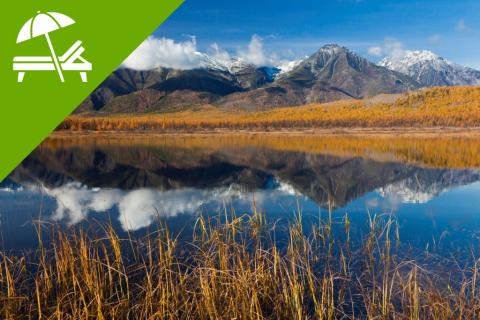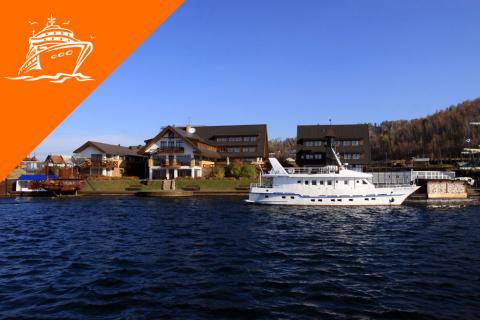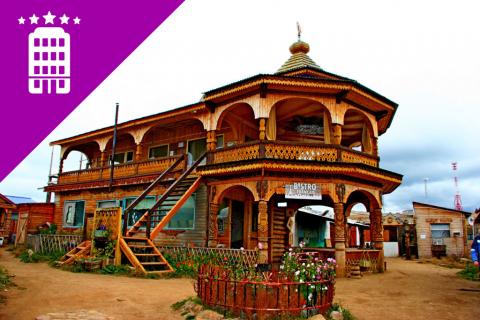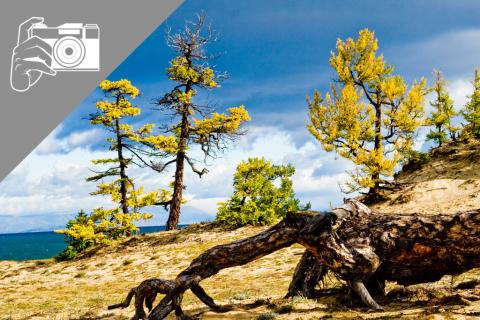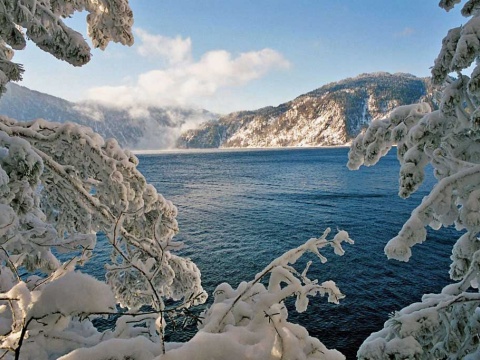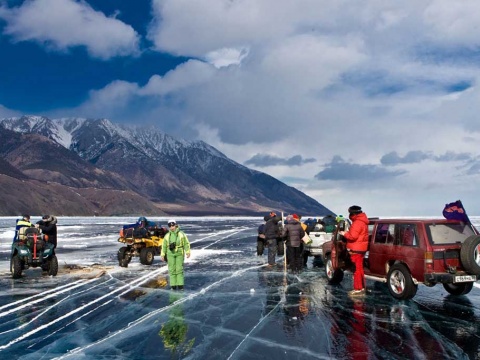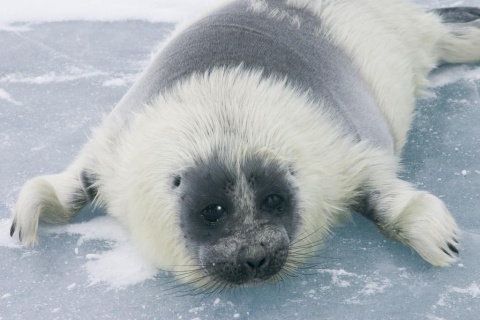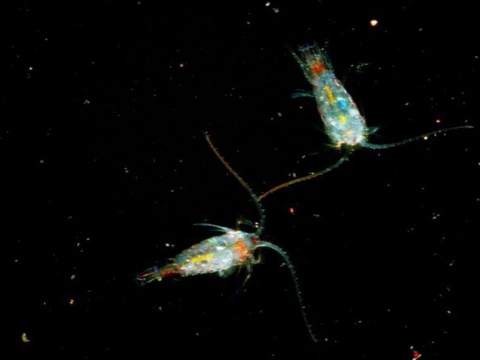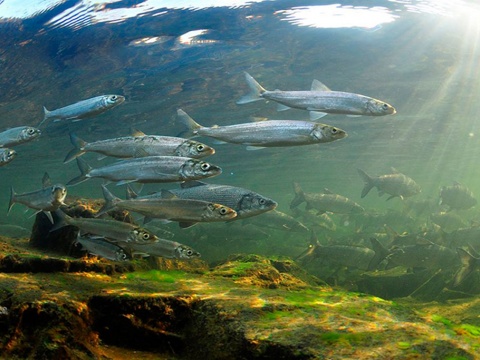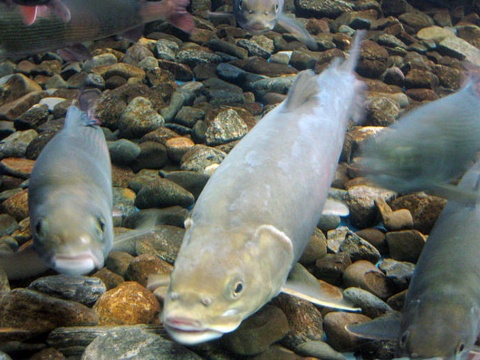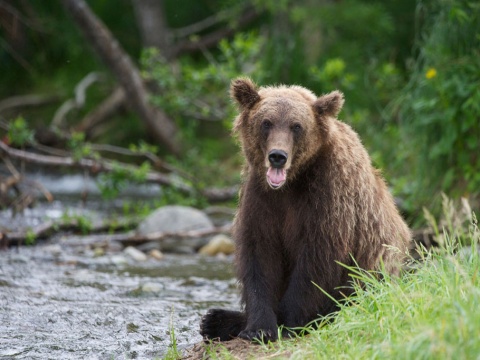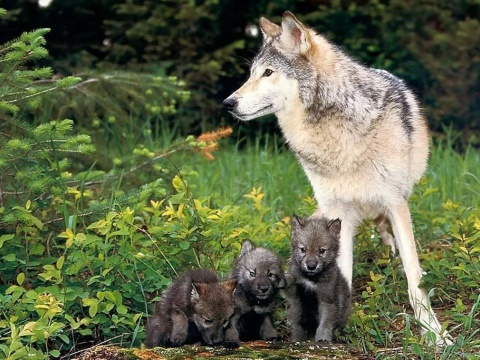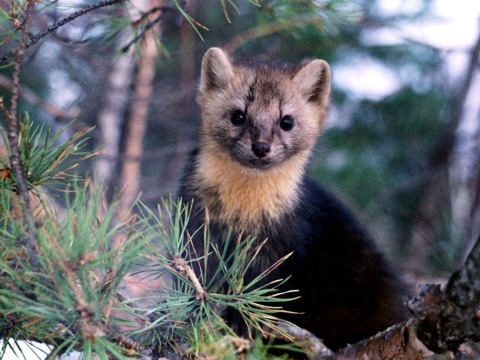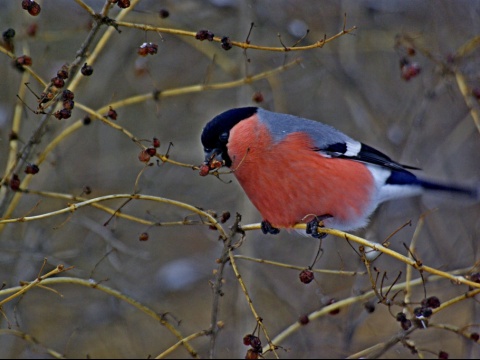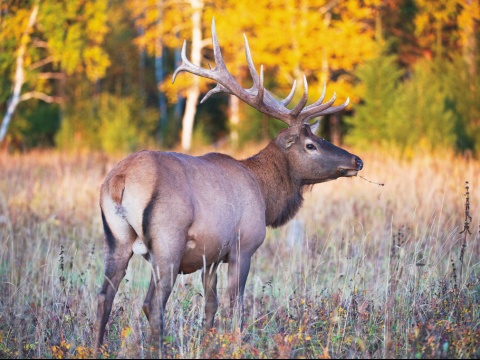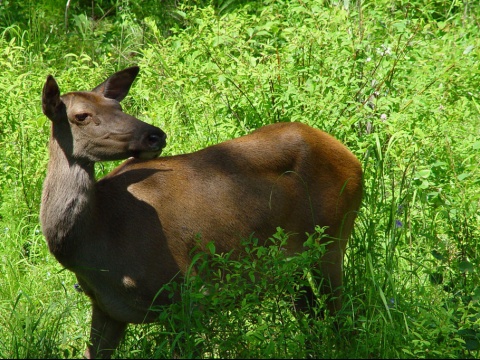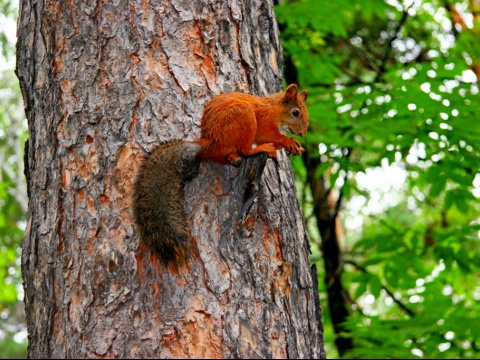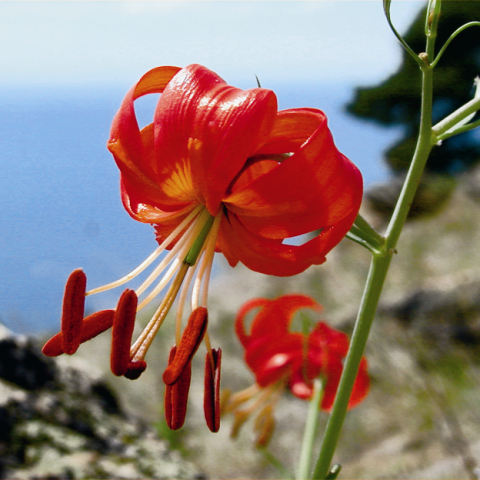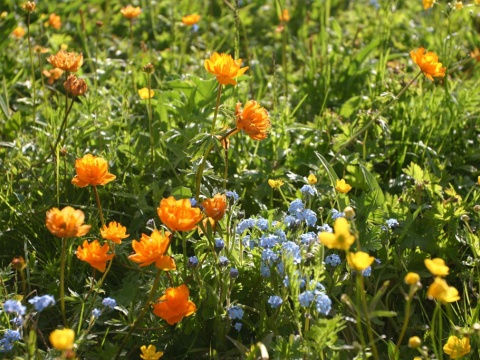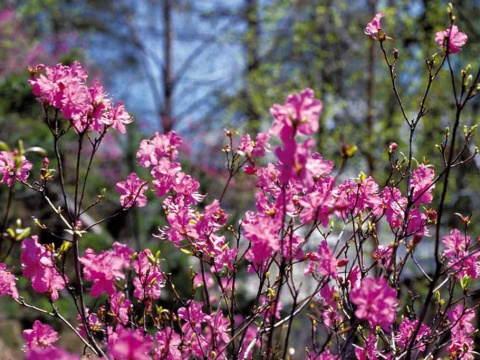- Lake Baikal is often called the Pearl of the World, for its beauty, unique natural features, its flora and fauna.
- In 1996 UNESCO listed it as a World Heritage.
- Lake Baikal is the oldest lake in the world, which is 25-27 million years old.
Lake Baikal is the world's deepest lake with a maximum depth of 1637 m. 336 rivers flow into Lake Baikal and the Angara River is the only river that flows out of it. The city of Irkutsk is located on its banks. From ancient times people have called Baikal Sacred Sea. Baikal is the cleanest natural fresh-water reservoir in the world, and the water clarity is down to 40 meters which also is the deepest water clarity of lakes in the world. Within Lake Baikal there are 2635 known species of animals and plants and 2/3 of those are endemic.
The landscapes around Lake Baikal are diverse. There are the mountains with the Siberian taiga forest, rocks of peculiar shapes, plains with different colours of wildflowers and sunny bays. Special microclimate exists on the islands of Baikal. There are places where one can see age-old trees, in arid places of Olkhon Island the flower edelweiss grows and in the area of Ushkanie Island one can experience a seal-rookery. Drawings of an ancient and primitive civilization can be seen at the marmoreal cliff Sagan-Zaba which is on the shore of the lake. According to scientists the drawings were made 4000 years ago (2000 years B.C.) in what is known as the Stone Age period. Drawings of the primitive men can also be seen in Sakyurte Mountain on the bank of Anga River flowing in the lake. There are many pagan holy places in the Baikal region. One can visit a rite of a Buryat Shaman (Buryat is a local population of Mongolian physical type), get acquainted with the culture and the way of life of Buryat people.
On the way from the city of Irkutsk to the village of Listvyanka (the nearest village located on the shores of Baikal) one will encount the Siberian village of Taltsi. At this village you will be able to visit an ethnographical museum which will introduce you to the history of the development of Siberia, its traditions, way of life. You will visit the wooden fortress, see implements and 300 year old buildings made of wood without nails. At both Taltsi and Listvyanka one will be able to buy traditional souvenirs and homecrafts that are specially made in Baikal region only.
Animals and plants
There are about 3500 species of plants and animals in Lake Baikal and about 84% of them are endemics, which means that they can be found in Baikal only. According to the scientists' research there are even more unknown species, as new varieties of organisms and plants are continuously developing in the lake.
Throughout its history both Baikal itself and the organisms inhabiting its world have undergone a complicated evolution. Because of this, the lake is inhabited both by very ancient varieties of organisms that originated in small lake pre-dating Baikal and younger ones that originated in Baikal itself.
The most famous endemic of the lake is a fresh-water seal, locally called "nerpa". It has always been of great interest. Nerpa lives up to 55-60 years, while the average age of other seals from European lakes is only 30-35 years. It can stay under the water for about 70 minutes. One theory holds that the seal came into Baikal from the Arctic Ocean through the Lena River in prehistoric times, when it was part of an integral system with the lake. This theory finds support in the fact that chromasomic analyses and other data favor of the arctic-sea seal as its closest relation. However, there are many differences between the nerpas and related seals. The Baikal seals are more graceful, especially the females. They also differ from others by the silver- grey colour of their skin and have 2 more litres of blood, which enables them to do without fresh air for almost 70 minutes.
Baikal has more than 1000 species of aquatic flora! Besides the algae, about 20 species of flowering plants have been found here. The lake's bays and silty lagoons, its sheltered coves, and the river deltas harbour such plants as thin reed, water buckwheat, cattail, hornwort, and sedge.
The most numerous inhabitant of the lake's water is a copepodae crustocean - the Baikal epischura. It is about the size of a manna-croup grain; a size of 1.5 millimeters is 'gigantic' for it. However, it accounts for 96 per cent of Baikal zooplankton.
The epischura plays an exceptional part in Baikal's life circle. Without any exaggeration, one can say that the epischura is the major filter of Baikal. According to academician G. Galazy, a well-known scientist (Lake Baikal, 1979), "throughout the year all crustaceans of this species filter from 500 to 1000 cubic kilometres of the Baikal water or more, which is 10-15 times more than the annual in-flow of water from all tributaries." The epischura lives only in cold clean water with a constant chemical composition and high saturation with oxygen.
Golomyanka (oil fish). The most interesting of bullheads are these fishes! Golomyanka can be found nowhere else on the earth. It is unusually beautiful, sparkles blue and pink in sunshine. However, the sunshine causes it to melt! Only bones and a fat spot will be left there. It contains about 30% of oil, rich in vitamin A. There was a time when Tibetian monks came to Baikal and gathered golomyanka along the shores. Its fat was used as a remedy for many diseases. Native Siberians used it as the fuel for their lamps, and also medicinally. Old residents said that long time ago, after the storms, golomyankas were picked alongside the shores, the fat was melted and used in treatments for rheumatism, atherosclerosis and for healing wounds. It is noted that the golomyanka is very sensitive to the temperature of water. Its optimal temperature is up to +5°C, and it avoids higher temperatures. It cannot survive at +10 °C or higher. This fish is small in size, 15-20 cm long. It's designed to live in extreme pressures. Interesting are vertical migrations of Golomyanka from small depth to bottoms of very deep depressions, where even a cannon cannot shoot (because of the enormous pressure). Golomyanka moves up and down obeying the waves. During migrations the change of pressure leads to forced stops necessary for the adaptation to existing conditions. At night Golomyanka rises to the water surface, and at daytime it swims down to great depths. Each autumn the females, being viviparous instead of laying eggs, produce 2000-3000 of larvae and die afterwards.
Omul has been the symbol of Lake Baikal, in addition to bread that has been a symbol of Russia since time immemorial. The instinct of continuation of generation forces the omul to overcome turbulent rapids and river shoals. The caviar is left on the sandy and pebbly bottoms with moderate flows, and the development of its larvae lasts 6-7 months. For different reasons, a greater part of the caviar perishes: it is either buried under sand and silt or eaten up by predators. Omul lives 18-20 years. It is assumed that the ancestors of omul got into Baikal from the polar regions - Arctic ocean. One theory is that there was a time when a group of omul, going with the stream up Arctic rivers to spawn, came to Baikal and favoured these conditions for breeding and development. Probably the rout of infiltration of this fish drove on Yenisei and Angara rivers. The omul's colonization of Baikal and its adaptation to new living conditions appeared to be Nature's tremendous experiment, revealing flexibility and adaptability of aquatic organisms to changes of the environment. Omul biomass in Lake Baikal by data of the survey made on May 25 - June 5, 1999 = 26000 ton (300 000 000)
The Baikal shore is a unique ecological niche the inhabitants of which are connected with both dryland and water. Some of them live on land but feed in water, others spend the greater part of the time in water but breed and end their lifetime ashore. Due to its unique location, the land animals of the Baikal region contain specimens of the fauna found in Central Asia, Europe - Siberia and East Asia. Furthermore, the taiga near-lake backwoods are inhabited by rare animals which have become extinct in other places.
Among the upland high ridges, the mammals most widespread are mountain goat, snow sheep, Alpine field-vole, marmots, and in some places - lemmings. In summer on the slope and valley zones one can come across big ungulate animals and their predators, brown bear in particular.
Bears generally weight 200-300 kilos. A bear entering hibernation weights 60% more than it did a few months earlier. In late autumn they retire to their winter den. It's often just a space under or over a hanging rock, or a fallen tree. Bears are not true hibernators and may be aroused easily without too much difficulty. However, their heart beat, breathing rate, and temperature are depressed. This slowdown of body functions will help to conserve the stores of fat. Local bears leave their den by mid April or early May. A female bear may give birth to cubs in late January. The cubs are tiny - about the size of chipmunks. The cubs stay with their mother through the summer and then share the den in the following winter. Mother and father have full charge of the young. The bear is territorial by nature and each bear has its own area that it uses and protects. In the water, it is a strong swimmer.
Rein deer, white tailed deer, elk, moose, musk deer, Siberian roe, wild boar, are typical fauna between the Alpine belt and the sparse growth of trees and the coniferous taiga zone.
The Wolf is a member of the dog family. These animals are divided into packs which are believed to be a family group. Each mated pair produces a litter of about 5-6 pups in May. Wolves are highly social by nature. Each pack is well-organized and has its most dominant and submissive family member. Research has shown that a wolf is not a reckless killer of wild life and therefore it's prey is mostly old and sick animals. Wolves are stimulated to chase any animals that will run from them.
Siberian forests are famous for 69 species of fur bearing animals. 29 of them are found in Baikal region.
At the most inspired hour, Nature presented the world with sable - the most typical and valuable inhabitant of the south Siberian mountain taiga. What does this little animal mean to Russia? Russians followed the sable trail throughout Asia to the Pacific Ocean. In the XVII th century fur-trade made up half of the national income of Russia. Salaries were paid in sable skins, debts were also repaid in sable; Russian tsars presented the nobility of Europe and East with sable.
Sable fur is valued not only for its beauty, but because Sable fur is valued not only for its beauty, but because it is rather practical and durable. Nowadays, there is a great demand for sable at international fur auctions. Sable, or the "fur-king" as it is sometimes called, was awarded several gold medals.
It is not very easy to see a sable in the taiga. The sable is a very careful and extremely secretive predator. Sable hunting requires special hunting skills, endurance and also good knowledge of the animal's habits and habitat.
FLORA
Nature is very generous to Lake Baikal. A necklace of coniferous forests, decorating the shore mountain chains, creates a unique beauty of landscapes, shelters animals and birds, and enlivens the surroundings. The pride of Pribaikalye is the taiga forest. The light green of larch, birch, poplar and alder trees growing in the lower belt, covers the slopes. Higher up it is replaced by a belt of a dark coniferous forest - cedar, fir and spruce. Up this belt the slopes are covered with impassable brushwoods of trailing cedar, through which only bear trails run. Above them on the gentle sloping terrace there are Alpine grasslands with parterres and finally, snowcovered peaks.
In contrast to European new woods the Baikal taiga has preserved trees of all ages - from young ones to 500-600 and even 800 year old giants. It is the only place where pine forests, with the world famous Angara pine tree, extend. Its timber has no match. In the undergrowth of pine forests, on the former burnings and clearings, one can come across rich red bilberries and on the hillsides, fern thickets.
Mixed pine-birch and birch-aspen forests have rather a wide spreading, as it is a stage of indigenous pine reforestation.
The most precious woods in Pribaikalye are cedar groves. The major forestry areas are located in the east of the Central Siberian Upland.
Spruce and firewoods are the least in Pribaikalye. They grow mostly alongside cedar, larch and sometimes, pine trees.
Among non-forest types, most widely spread are steppe, Apline meadowland and marsh vegetation. The Alpine flora is rich in colourful, ornamental plants, e.g. vodosbor, Aquilegia (Lat.); gorechavka Gentiana (Lat.), cyclamens, herbs and "zharky" (endemic flowers of bright yellow colour).
Meadowland vegetation is firstly water meadows along the valleys of big and small rivers, located mostly near hamlets and villages.
Marshes in Pribaikalye dominate in cold areas. The taiga swamps are rich in cranberries and fragrant currants.






